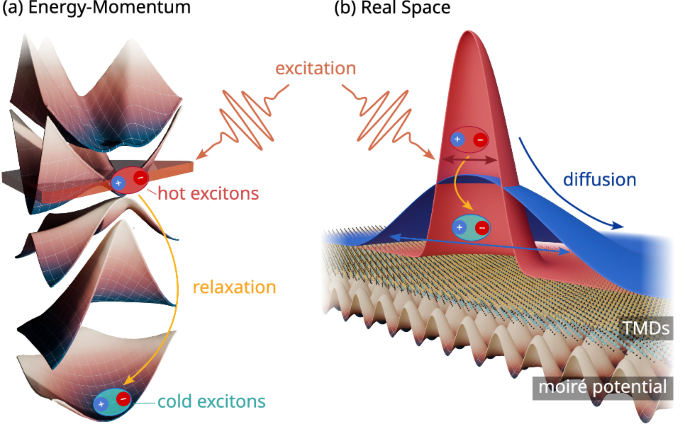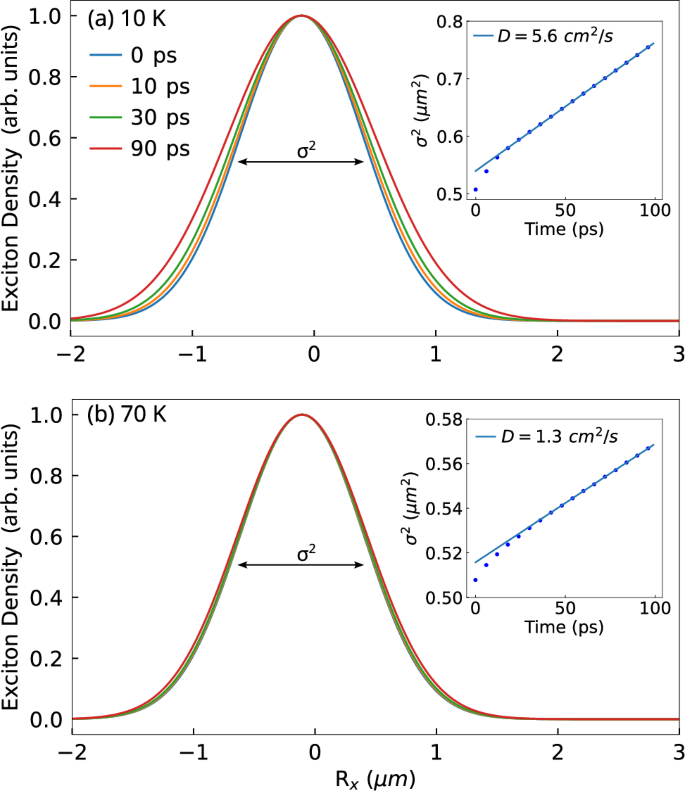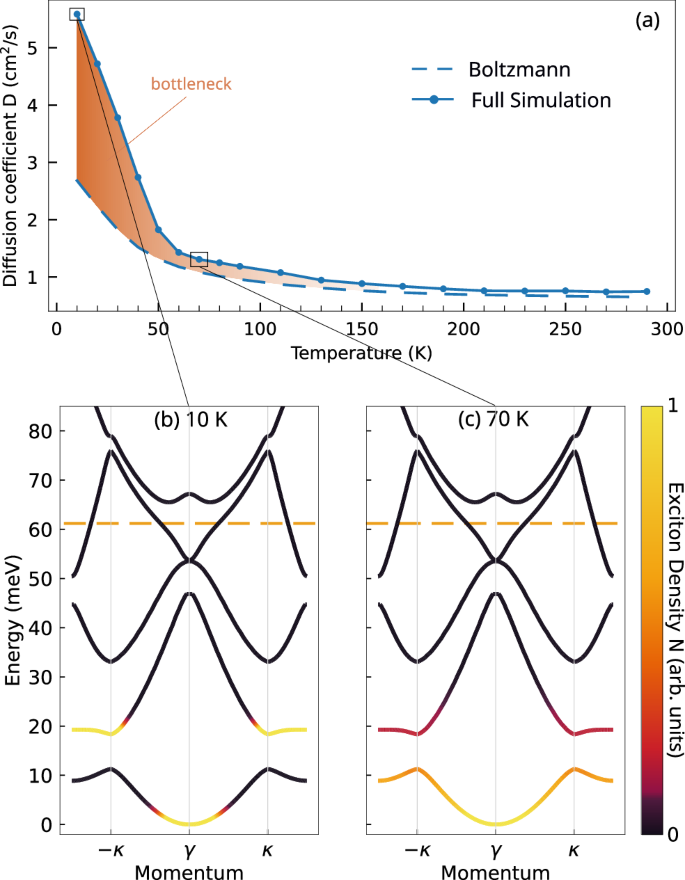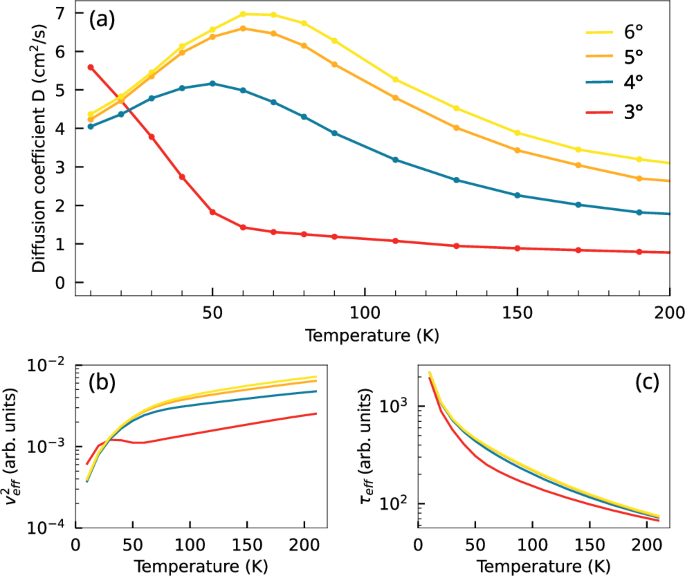Microscopic model
We study the spatiotemporal moiré exciton dynamics in a twisted TMD heterostructure in the low excitation regime, where the exciton density remains low, so that exciton-exciton interactions can be neglected. Our approach is based on an equation-of-motion formalism33,34,35,36. A transformation to the Wigner representation results in a Boltzmann transport equation in the moiré exciton basis (Eq. (3) in the methods section). In this way, we can track the time evolution of the exciton distribution in momentum, energy, and space in the presence of a periodic moiré potential. In contrast to the case of free excitons characterized with a parabolic dispersion, where the thermal equilibrium is described by a Boltzmann distribution, the inclusion of the moiré potential drastically increases the complexity of the problem. The moiré-modified bands are not parabolic anymore, i.e., we cannot restrict the study to the solution of the radial component, but the full two-dimensional momentum-dependent band structure has to be taken into account. Furthermore, the number of relevant moiré exciton subbands within the thermal energy window increases substantially as the twist angle decreases. Moreover, the thermalization dynamics can exhibit pronounced relaxation bottleneck effects, leading to considerable deviations from the standard Boltzmann distribution. To be able to capture the full spatiotemporal moiré exciton dynamics, we solve the Boltzmann transport equation in both momentum and real space, employing a Monte Carlo algorithm37,38,39 to manage the high dimensionality of the problem. This material-specific and microscopic framework allows us to analyze how the interplay of the moiré band structure and phonon-mediated relaxation channels governs the diffusion process. The developed theoretical framework is applicable to a larger class of moiré systems, including lattice-mismatched heterobilayers, by appropriately adjusting the mapping between the twist angle and the moiré potential strength. Key equations are presented in the Methods section, and further technical details are provided in the Supplementary Information.
Moiré exciton diffusion
We apply our model to the exemplary twisted hBN-encapsulated WSe2-MoSe2 heterostructure. In this material, interlayer KK excitons are the lowest energy states, where the electron and hole reside in different layers40,41. This spatial separation gives rise to a permanent out-of-plane dipole moment and results in an extended exciton lifetime7,16,17,18,40,41,42. Due to the weak interlayer tunneling near the K points, this state remains largely unaffected by layer hybridization15,43. As a consequence, the moiré potential can be effectively described by using a continuum model including hybridization in momentum space23. We initialize an exciton distribution with a Gaussian profile in real space, characterized by a standard deviation of 1 μm, and a uniform energy distribution of approximately 60 meV, focusing on an intermediate twist angle of 3°. At very small twist angles around 1°, exciton dispersion becomes completely flat and localizes excitons in the moiré potential minima23. Here, the group velocity of excitons becomes zero, inhibiting transport in the low-density regime, as observed experimentally28,29 and predicted theoretically32. Therefore, in this work, we focus on an intermediate range of twist angles, where the moiré potential significantly modifies the excitonic band structure, but does not completely trap excitons.
By solving the Boltzmann transport equation (Eq. 3), we track the time- and space-dependent evolution of the exciton population. In particular, we study exciton mobility and quantify the impact of the moiré potential on spatial diffusion by extracting the diffusion coefficient D. The results are presented in Fig. 1, where we show time-resolved spatial profiles of the exciton distribution. Each profile is individually normalized to highlight the progressive broadening of the distribution over time. The insets illustrate the variance σ2 of the exciton distribution as a function of time, with the slope determining the diffusion coefficient \(D=\frac{1}{4}{\partial }_{t}{\sigma }_{t}^{2}\) 36. We perform the simulations under identical initial conditions at two different temperatures. A quantitative comparison of the extracted diffusion coefficients reveals a distinct temperature dependence. At 70 K, we obtain D = 1.4 cm2/s, whereas at 10 K, the diffusion increases by almost a factor of 5 to D = 6 cm2/s.
Fig. 1: Schematic of the system under study.
a A twisted TMD heterostructure is optically excited, creating an initial population of hot excitons (represented by the red contoured and shaded electron-hole pair bubble) with an energy of 60 meV (indicated by the orange plane pointed to by the arrow in the excitonic subband structure). b Spatial distribution of excitons with a 0.5 μm width (red Gaussian). The system undergoes an energy-momentum thermalization (orange arrows connecting red excitons (hot) to blue excitons (cold)), accompanied by time-dependent spatial diffusion, illustrated by the blue arrow denoting the broadening of the spatial exciton distribution (blue Gaussian). Both processes are strongly dependent on twist angle and temperature.
Diffusion coefficient analysis
To explore in detail the influence of temperature and energy relaxation on real-space exciton dynamics, we calculate the diffusion coefficient as a function of temperature, cf. Fig. 3(a). In particular, we compare our findings with the case of an ideal Boltzmann-distributed exciton population by using the analytical expression for the diffusion coefficient, obtained within the relaxation-time approximation (more details can be found in the Supplementary Information.)
$$D=\frac{1}{2} {\sum}_{{{{\bf{k}}}}\eta }| {{{{\bf{v}}}}}_{{{{\bf{k}}}}}^{\eta }{| }^{2}{\tau }_{{{{\bf{k}}}}}^{\eta }{N}_{{{{\bf{k}}}}}^{\eta }$$
(1)
with the moiré exciton distribution \({N}_{{{{\bf{k}}}}}^{\eta }\). The diffusion coefficient D is governed by a competition between the squared group velocity \(| {{{{\bf{v}}}}}_{{{{\bf{k}}}}}^{\eta }{| }^{2}\) and the scattering time \({\tau }_{{{{\bf{k}}}}}^{\eta }\), which has been obtained as the inverse of the total out-scattering rate from the state η (see the Supplementary Information. for more details). At low temperatures, we predict significant deviations from the Boltzmann behavior, cf. the orange-shaded area in Fig. 3a. Although flat bands should suppress diffusion due to the vanishing group velocity, surprisingly, we observe an opposite trend: for temperatures below 70 K, we find a significant enhancement of exciton diffusion. The diffusion coefficient at 10 K reaches a value of D ≃ 5.6 cm2/s that is more than double the value of D ≃ 2.7 cm2/s expected for a Boltzmann distribution.
To gain further insight, we examine the stationary exciton distributions obtained at two representative temperatures of 10 K and 70 K. At lower temperatures, excitons remain trapped (bottleneck effect) in relatively flat regions of the dispersion landscape (cf. Fig. 3b, showing the exciton occupation superimposed on the band structure along the path γ → κ → m). Here, the mismatch between the interband energy gap and the energies of the dominant optical phonons prevents further relaxation to the ground state via phonon emission44. However, the excitonic band structure is not flat in all directions, and the thermal population can partially extend into more dispersive regions of the moiré Brillouin zone (cf. the schematic 3D plot of the excitonic band structure in Fig. 2, allowing excitons to access states with higher group velocities. This directional extension of the population explains the larger diffusion coefficient compared to the fully thermalized case, despite the apparent flatness seen along the plotted path. This is a counterintuitive result, as one might expect flat bands to trap excitons and hinder their propagation. The situation is considerably different at 70 K, where the ground state clearly has the largest occupation and the higher energy bands are only weekly occupied as expected from an equilibrium Boltzmann distribution (cf. Fig. 3c).
Fig. 2: Spatial distribution time evolution.
Time-dependent real-space cuts along the x direction (Rx) of the exciton distribution in an hBN-encapsulated WSe2-MoSe2 heterostructure for a twist angle of 3° and at a temperature of (a) 10 K and (b) 70 K. Insets show the variance σ2 of the spatial distribution over time (blue dots). An initial non-linear increase (within the first tens of ps) corresponds to a higher diffusion coefficient reflecting the propagation behavior of transient hot excitons. At later times, we find a linear regime that is used to extract the stationary diffusion coefficient (blue solid lines).
Fig. 3: Temperature-dependent diffusion coefficient.
a Temperature-dependent diffusion coefficient for hBN-encapsulated WSe2-MoSe2 heterostructure with a twist angle of 3°. Simulation results (solid-dotted line) are compared with the case assuming a Boltzmann distribution (dashed line). Strong deviations for temperatures lower than approximately 60 K arise due to a pronounced relaxation bottleneck. Exciton occupation at equilibrium (color-coded) overlaid on the exciton subband structure at a temperature of 10 K (b) and 70 K (c). At low temperatures, excitons are trapped in local dispersion minima far from the ground state. They exhibit a larger group velocity and thus lead to an effective increase in the diffusion coefficient compared to the Boltzmann case. At high temperatures, full relaxation is restored, and the simulation aligns well with the Boltzmann model. The orange dashed line represents the energy initialization condition.
The flatness of exciton subbands plays a crucial role for the efficiency of possible phonon-driven scattering channels. Therefore, we investigate now the role of the twist angle that can be used as a tuning knob for the exciton band structure and thus also for the exciton propagation. Figure 4a displays the diffusion coefficient as a function of temperature for various twist angles. Two distinct regimes can be identified: one at higher temperatures (>50 K) and one at low temperatures (<50 K). In the high-temperature regime, the diffusion coefficient increases monotonically with the twist angle, approaching the asymptotic value expected for interlayer excitons with a parabolic band. In contrast, at lower temperatures, the presence of the moiré potential induces miniband gaps and flat-band regions of vanishing group velocity. The smaller the twist angle, the larger the energy gaps and the flatter the bands23. As a result, one would expect excitons to be at least partially trapped at lower twist angles, significantly reducing their diffusion. However, as already observed in Fig. 3a, exciton diffusion becomes considerably faster at the smallest considered twist angle of 3° and at low temperatures, cf. Fig. 4a. Moreover, for 3°, the diffusion coefficient decreases with increasing temperature, while higher twist angles exhibit a non-monotonic temperature dependence.
Fig. 4: Twist-angle-dependent exciton diffusion.
a Twist angle and temperature dependence of the diffusion coefficient. At temperatures higher than 60 K, the diffusion coefficient increases with the twist angle, driven by the concurrent rise in both the effective group velocity \({v}_{{{{\rm{eff}}}}}^{2}\) and the effective scattering time τeff shown in (b, c) respectively. At low temperatures (T < 50 K) and for the smallest angle of 3°, the dynamics is dominated by the relaxation bottleneck giving rise to an occupation of hot excitons in higher exciton bands and as a consequence to an enhanced diffusion coefficient. In this regime, the squared effective group velocity \({v}_{{{{\rm{eff}}}}}^{2}\) at 3° exhibits a non-monotonic dependence on temperature. Here, low-temperature velocity values exceed those of larger twist angles, highlighting the direct impact of the bottleneck on the effective excitonic group velocity.
To understand these remarkable observations, we return to the analytical expression for the diffusion coefficient in Eq. (1). While the scattering time τ generally decreases monotonically with temperature, due to enhanced exciton-phonon scattering, the group velocity contribution increases, as higher-energy (steeper) regions of the bands become thermally accessible. Although both quantities contribute to the diffusion coefficient D via a momentum and band-summed integral, qualitative trends can be captured by introducing an effective group velocity squared \({v}_{eff}^{2}={\sum }_{\eta {{{\bf{k}}}}}{v}_{\eta {{{\bf{k}}}}}^{2}{N}_{{{{\bf{k}}}}}^{\eta }\) and an effective scattering time \({\tau }_{eff}={\sum }_{\eta {{{\bf{k}}}}}{\tau }_{\eta {{{\bf{k}}}}}{N}_{{{{\bf{k}}}}}^{\eta }\). These are shown in Fig. 4b, c as a function of temperature for different twist angles. While τeff increases monotonically with the twist angle, \({v}_{eff}^{2}\) becomes significantly enhanced at low temperatures in the case of 3°, due to the non-thermal exciton distribution caused by the bottleneck effect as shown in Fig. 3b. As thermal broadening activates scattering into lower-energy (flatter) regions of the band structure, the expected trend of increasing \({v}_{eff}^{2}\) with twist angle is recovered at higher temperatures.
The non-monotonic temperature dependence of the diffusion coefficient observed for twist angles above 3° arises from a subtle competition between two processes: thermal occupation favors higher-velocity states (increasing \({v}_{eff}^{2}\) with temperature), while enhanced phonon scattering reduces τeff. For twist angles beyond the bottleneck regime (e.g., >3°), this interplay leads to a maximum in the diffusion coefficient at the temperature where the decrease in τeff begins to dominate the gain in \({v}_{eff}^{2}\). Moreover, the position of this maximum slightly shifts with the twist angle, which we attribute to twist-induced changes in the effective exciton mass. In contrast, the monotonic decrease in the diffusion coefficient for 3° can be understood by considering the exciton band structure in Fig. 3b. The band gap lies within the thermally populated region between 40 K and 70 K. The absence of available states in this energy window prevents the group velocity from compensating for the temperature-induced decrease in scattering time, leading to a sharp drop in the diffusion coefficient.
